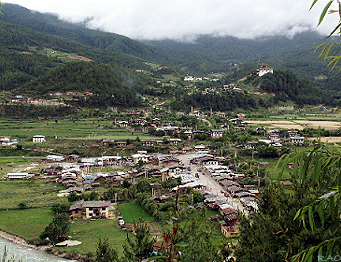|
Bhutan's
Economy - Tourism
|
 |
Bhutan Economy |
 |
Bhutan Information |
|
|
 |
|
Tourist
lodges thrive in Bumthang
|
 |
 Small
industries gain from tourism Small
industries gain from tourism
|
 |
 |
| Jakar Town |
Besides
the hotels and guest houses, Bumthang's small industries too gain from
tourists. The milk processing unit in Badbalathang has its best sales of
dairy products during the autumn season and the Bee Keepers Association
of Bhutan (BEKAP) which produces honey depend largely on sales to tourists.
Small
time craftsmen and weavers are also able to sell their goods while
the locally brewed Red Panda beer is a best selling item with tourists.
|
|
"Bumthang
is definitely emerging as a popular tourist destination,"
says an official of the department of tourism. "Perhaps its only draw back
is the (driving) time to get there."
 |
| Jakardzong |
Besides
tourists, guests of expatriates working in Bhutan and 'official guests'
also try and make it to Bumthang for the festival season which includes
the Jambay Lhakhang Drubchen, the Jakar Tshechu and other local
Tshechus such as the Ura tshechu which are actively promoted by tour
operators.
The Bumthang
cultural trekwhich takes visitors through villages and places of historical
and cultural interest is also popular. Meanwhile the construction of a
luxury resort that will cater to a high end tourist market has already
begun in Bumthang. |
|
But the existing hotel and guest house owners are least
worried.
The
blessed valley of Bumthang, home to some of the oldest religious as well
as historical monuments and Nyes dating back to the 7th century has always
been an important tourist destination.
top
 Nomad festival in Bumthang 2009 - Community-Based Tourism Nomad festival in Bumthang 2009 - Community-Based Tourism |
 |
Nomads from across the country have come together to take part in the first ever nomad's festival, that begun at the usually quiet Wangchuck centennial park (WCP)in Nagsiphel, Bumthang.
Dotted with tents, temporary bamboo shelters and colourful flags, about 39 acres of land in Nagsiphel, (around 22 km from the Chamkhar town) has been brimming with activity for the past month.
Some of the 90 nomads from the eight dzongkhags of Haa, Paro, Thimphu, Gasa, Wangdue Phodrang, Bumthang, Trashiyangtse and Trashigang have walked for days to participate in the three-day festival that aims to boost community-based tourism.
Fifteen people from Laya, including a 69-year old woman and a 12-year old girl walked for seven days with their locally produced goods to participate in the festival. They said they were picked up from the road head by a bus arranged by the festival's organiser.
"Bumthang is very beautiful, it's similar to Laya,"said Pem Zomki, a mother of four."There's no work around this time of the year in Laya, as it remains under snow and most of us weave, so I'm happy to be here and sell our products.".
Tshering, 37, like the rest of the nomads, is looking forward to sell the goods he brought to Bumthang."Besides yathra, the rest is all available in Laya,"he said."We hope we'll sell all the cheese, the clothes and jewelry we brought with us with so much trouble."
On offer is a price range from Nu 50 for a chain of hardened cheese, to some goods, such as the koma, an ornament Layap women use, which costs as much as Nu 15,000.
Cut off from the rest of the country most of the time, the festival is an exposure for the nomads, some of who have already visited some holy sites like the Mebartsho and the Kurje lhakhang. Coming from higher altitudes, they are not complaining of the cold in Bumthang."Around 11 of us are staying in this room,"said Om, 37, showing the small bamboo shelter they will live in for the next three days."We don't feel the cold at night because all of us sleep together."
The 17 nomads from Sakteng, Trashigang, who walked for two and half days to the road head, are another group looking forward to sell their 400 kg of famous Sakteng zoetey, fermented cheese."A kilo costs Nu 260 and we hope that we'll be able to sell it all,"said 50-year old Leki Phuntsho, the oldest in the group.
The Nu 3 million festival is organised by the agriculture ministry to promote community-based tourism, add to the diversity of tourist experiences and to make off-season months attractive to tourists."The festival has helped people from Paro to Nasiphel,"said the assistant forest officer of WCP, Tenzin."Everyone involved benefits. It'll help supplement incomes for nomadic groups through sale of their livestock products; for local communities through home stays and catering services and for tour companies and local hoteliers from the lodging and food services."
| Contributed
by Sonam Pelden , KUENSEL, Bhutan's National Newspaper 2009 |
 |
top
| Information on Bhutan |
 |
|







